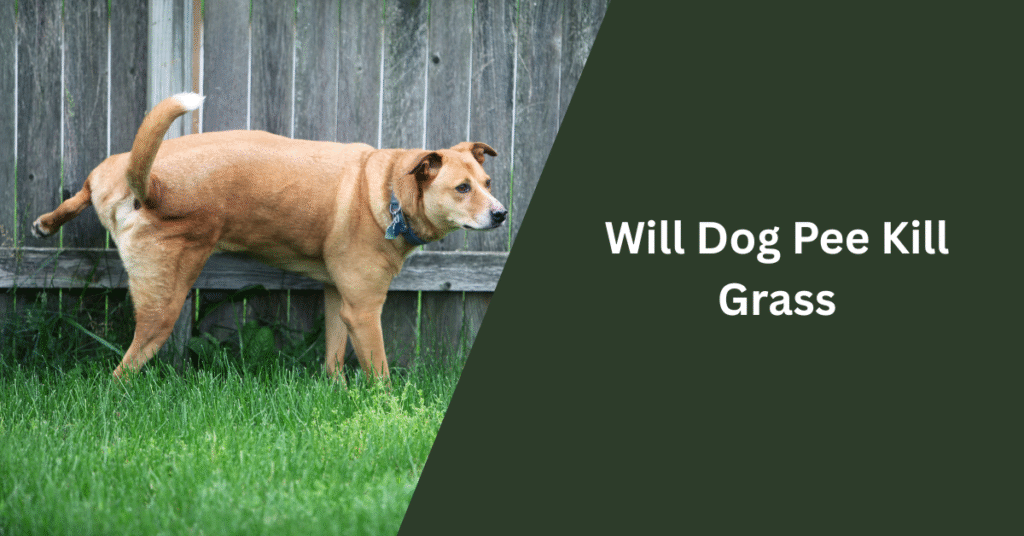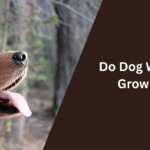Yes, Dog pee can kill grass because it contains high levels of nitrogen and salts that burn lawn roots. The concentrated nitrogen acts like an overdose of fertilizer, leaving yellow or brown dead patches. Damage is worse in small areas where dogs repeatedly urinate. Diluting spots with water or training dogs to use a specific area prevents lawn burn.
Why Dog Pee Can Kill Grass
Dog urine contains compounds that affect grass health. The concentration of these substances and how they interact with soil and grass types determine the extent of damage.
The Chemistry of Dog Urine
Dog urine is primarily made up of water but contains waste products like urea, ammonia, creatinine, and uric acid. Urea breaks down into ammonia, which is toxic to grass in high concentrations.
Ammonia raises the pH level in the soil temporarily, creating an alkaline environment that grass roots find stressful. Additionally, the salts present in urine draw water away from grass cells, causing dehydration and browning.
The strength of the urine varies depending on the dog’s diet, hydration, and health, which affects how harmful the urine is to grass.
Understanding Nitrogen Buildup
Dog urine contains a high level of nitrogen, an essential nutrient for plants. However, when nitrogen accumulates quickly in one spot, it becomes toxic rather than beneficial.
Excess nitrogen causes a rapid increase in soil chemical concentration, leading to “nitrogen burn.” This burn damages or kills grass by disrupting root function and cellular processes.
Repeated urination in the same area amplifies nitrogen buildup. While low doses improve growth, concentrated deposits create brown or yellow patches known as “urine spots.”
How Soil and Grass Types React
Soil type affects how dog urine impacts grass. Well-drained sandy soils tend to reduce urine damage because they dilute urine quickly. Clay or compacted soils hold urine longer, increasing toxicity.
Grass species also influence vulnerability. Kentucky bluegrass and ryegrass are more sensitive to urine, showing visible damage faster. Fescue and Bermuda grass exhibit higher tolerance due to tougher root systems.
The combination of soil drainage and grass type dictates the severity and recovery speed of urine-damaged areas.
Signs and Symptoms of Grass Damage
Grass damage from dog urine shows distinct visual changes. These include color alterations, clear patterns on the lawn, and differences between affected and healthy grass. Identifying these signs helps confirm urine as the cause.
Yellow and Brown Spots
Yellow spots appear when grass blades suffer nitrogen overload from dog urine. This excess nitrogen acts like a chemical burn, killing some grass but often leaving the roots intact.
Brown spots develop when urine concentration is higher or exposure is prolonged. The grass tissue dies, turning brittle and dry.
The severity varies with urine volume, frequency, and grass species. Cool-season grasses like fescue often show brown spots faster than warm-season types, which might only yellow at first.
Patterns of Pee Burn
Urine burns typically form irregular circular or oval spots. These spots often occur where dogs urinate repeatedly or stand still while eliminating.
Clusters or streaks of such spots can appear along a path or near the base of favorite trees. The shape depends on how the urine soaks into the soil and grass blades.
Spot size ranges from a few inches to several feet. Larger patches often indicate multiple urine events in the same area.
Affected vs Unaffected Areas
Affected grass areas contrast sharply with healthy green zones. The damaged spots often have dry, brittle blades with little to no growth.
Nearby unaffected grass usually remains lush and green because it receives normal soil nutrients and moisture balance.
Comparing these areas helps distinguish urine damage from other lawn problems like fungal disease or drought stress, which show more diffuse or irregular patterns.
| Characteristic | Affected Area | Unaffected Area |
|---|---|---|
| Grass Color | Yellow to brown | Bright green |
| Texture | Dry, brittle | Soft, flexible |
| Growth Rate | Reduced or halted | Normal |
| Soil Condition | Often concentrated nitrogen | Balanced nutrients |
Preventing Lawn Damage from Dog Urine
Addressing lawn damage from dog urine involves specific strategies that reduce the concentration of urine on grass and guide dogs to less sensitive areas. Combining behavior training, proper watering, and selecting resilient grass types improves lawn health.
Training Dogs to Pee in Designated Areas
Training dogs to use a specific spot for urination limits lawn damage by concentrating urine in a controlled area. Owners should choose a spot with non-grass ground cover, like mulch or gravel, to minimize visible damage.
Consistency and positive reinforcement are key. Command the dog to the area, reward it when it urinates there, and use a fixed phrase like “Go potty.” Patience is necessary, as it can take weeks for dogs to learn.
Restrict access to vulnerable grass sections by using barriers or fences. Supervise the dog during outdoor time and redirect if it approaches damaged lawn areas. This method reduces spreading urine across the yard.
Watering Techniques to Dilute Urine
Immediate watering after the dog urinates helps dilute nitrogen concentration and salts, reducing grass burn. Use a hose or watering can to soak the urine spot thoroughly.
Water with about 1 liter (a quart) per urination spot to flush the urine through the soil. This prevents nitrogen buildup near grass roots.
Regular lawn irrigation improves overall grass resilience. Balance watering so the lawn stays healthy without overwatering, which can cause other problems like fungus.
Using Lawn-Friendly Grass Varieties
Certain grass species tolerate dog urine better than others. Fescues and ryegrass show higher resistance to urine damage compared to Kentucky bluegrass and Bermuda grass.
Planting a mix of durable grasses increases lawn survival chances. Choose varieties suited to the local climate and known for urine tolerance.
Consider drought-resistant grasses as they tend to have stronger root systems, helping recovery from urine exposure. Consulting local nurseries for appropriate selections is beneficial.
Effective Treatments for Damaged Lawns
Treating grass damaged by dog urine involves targeted repair, soil improvement, and knowing when to reseed. Each step helps restore lawn health and prevent recurring dead patches.
Repairing Burnt Grass Patches
When urine burns grass, removing dead patches is essential. Using a garden rake or hoe, clear away the damaged turf to expose soil underneath. This creates space for new growth.
Next, water the area lightly to help the soil settle. Applying a diluted lawn fertilizer can speed up recovery by providing nutrients depleted by urine salts.
Consistent watering over the following week promotes root establishment. Avoid walking on the patch until fresh grass begins to sprout to protect emerging shoots.
Applying Lawn Soil Amendments
Amending soil helps balance pH and nutrients altered by dog urine. Adding gypsum improves soil structure and reduces sodium buildup, which harms grass roots.
Organic compost or peat moss can also be mixed into the affected soil to boost moisture retention and microbial activity. These changes restore healthier conditions for grass growth.
A soil test is recommended before amendment. This guides precise adjustments necessary for balancing nitrogen, phosphorus, potassium, and pH levels impacted by urine deposits.
When to Reseed or Patch the Lawn
Reseeding is advisable if grass does not regrow within two to three weeks post-repair. Selecting a grass seed matching the existing lawn type ensures uniformity.
Patch seeding works well for small spots under two square feet. For larger damaged areas, overseeding the entire lawn section provides better coverage.
Timing affects success; early fall or spring gives seeds optimal moisture and temperature for germination. Avoid reseeding in extreme heat or drought conditions to improve seedling survival.
Long-Term Strategies for Healthy Lawns and Pets
Maintaining a healthy lawn while caring for a dog requires consistent effort in both pet management and lawn care. It involves adjusting the dog’s diet, following a lawn maintenance routine, and balancing the needs of the lawn with the pet’s habits.
Adjusting Dog Diets for Less Harmful Urine
A dog’s urine composition directly affects grass health. Diets low in protein and high in water content typically produce less concentrated urine, reducing lawn damage. Adding supplements such as beet pulp can dilute urine nitrogen levels.
Avoid feeding excessive protein or synthetic additives, as they increase nitrogen and salt in urine. Increasing water intake helps dilute harmful components. Freshwater should be available to the dog at all times.
Regular vet check-ups ensure there are no underlying health issues causing unusually strong urine. Small changes in diet can have a measurable impact on reducing burned spots on grass.
Regular Lawn Maintenance Tips
Frequent watering helps dilute urine patches, preventing permanent grass burns. Watering immediately after a dog urinates on an area minimizes nitrogen concentration.
Mowing grass regularly, at a moderate height of 3 inches, improves resilience. Aerating soil reduces compaction and improves water absorption.
Fertilizing with balanced, slow-release nitrogen helps repair damaged areas but avoid over-fertilizing, which worsens issues. Reseeding bare patches with grass varieties tolerant to wear, such as fescue or ryegrass, improves recovery.
Balancing Pet Needs with Lawn Health
Designating specific “potty zones” with durable surfaces like gravel or mulch can protect the rest of the lawn. Training the dog to use these zones consistently helps maintain grass health.
Frequent bathroom breaks reduce urine concentration per spot. Walking the dog to these areas encourages use and preserves larger lawn sections.
Using pet-friendly lawn products ensures chemicals do not harm the dog. Regular monitoring of lawn condition helps identify problem areas early for prompt care or treatment adjustments.
Conclusion
In conclusion I would say that the dog pee can kill grass because it contains high levels of nitrogen and salts, which in small amounts can act like fertilizer but in excess will burn and damage the lawn, leaving behind yellow or brown patches.
The good news is that damage can be minimized with simple steps—such as watering the spot immediately after your dog pees, training your dog to use a designated area, adjusting their diet if recommended by a vet, and choosing more urine-resistant grass varieties.
I’ve loved dogs all my life and have cared for many different breeds over the years. Here, I share simple tips, stories, and helpful advice for all dog lovers. Whether you’re a new pet parent or a lifelong dog fan, you’ll find something useful and fun on my site.


